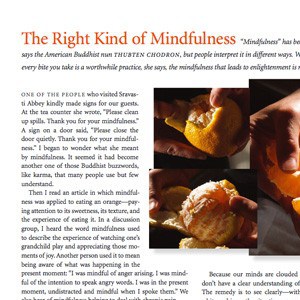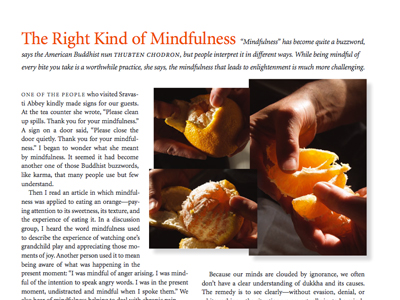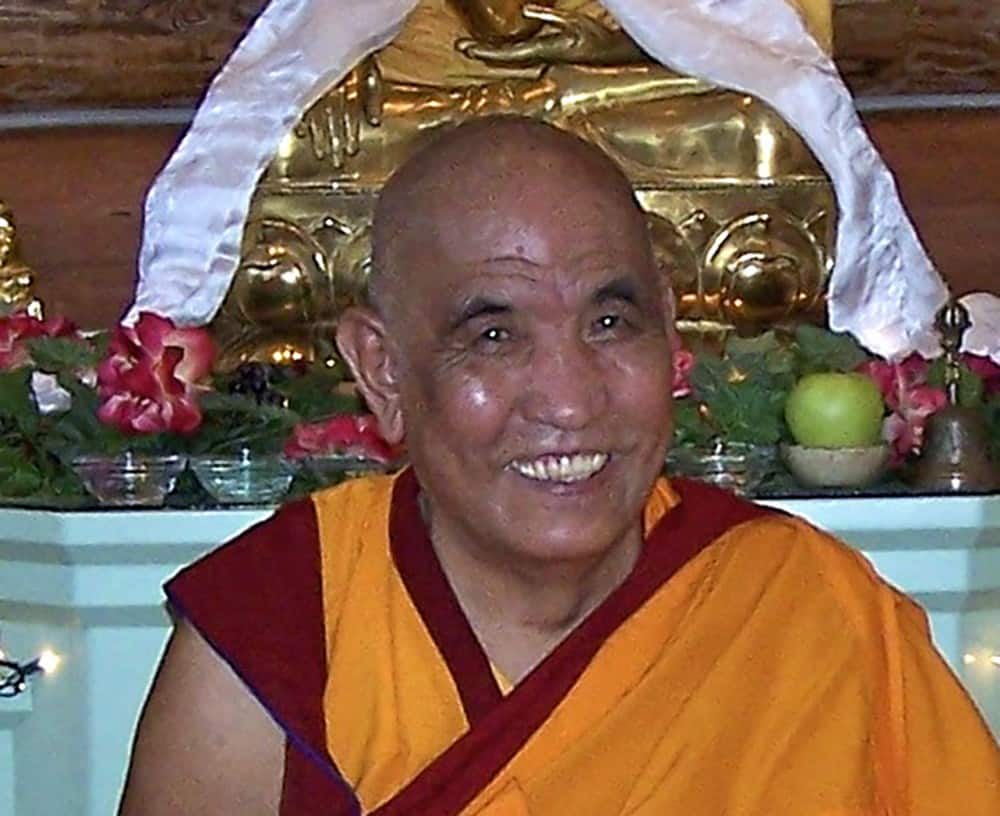The right kind of mindfulness

Article from Shambhala Sun, September 2006
One of the people who visited Sravasti Abbey kindly made signs for our guests. At the tea counter she wrote, “Please clean up spills. Thank you for your mindfulness.” A sign on a door said, “Please close the door quietly. Thank you for your mindfulness.” I began to wonder what she meant by mindfulness. It seemed it had become another one of those Buddhist buzzwords, like karma, that many people use but few understand.
Then I read an article in which mindfulness was applied to eating an orange—paying attention to its sweetness, its texture, and the experience of eating it. In a discussion group, I heard the word mindfulness used to describe the experience of watching one’s grandchild play and appreciating those moments of joy. Another person used it to mean being aware of what was happening in the present moment: “I was mindful of anger arising. I was mindful of the intention to speak angry words. I was in the present moment, undistracted and mindful when I spoke them.” We also hear of mindfulness helping to deal with chronic pain.
While some of these examples are valid and beneficial uses of mindfulness practice, do they lead to enlightenment? Are they examples of mindfulness as understood in traditional Buddhist texts, where mindfulness is an essential component of the path to liberation?
“Mindfulness” is a comfortable word for Americans; “renunciation” is not. Renunciation conjures up images of living in a cold, damp cave, eating bland food, remaining with no companions and no TV, iPod, cell phone, computer, credit cards, or fridge. In our consumer culture, renunciation is seen as a path to suffering. Like mindfulness, renunciation is not well understood in America.
As the Buddha defined it, renunciation is a determination to be free from dukkha, the unsatisfactory conditions and suffering of cyclic existence. Renunciation is being determined to give up not happiness, but misery and its causes.
Because our minds are clouded by ignorance, we often don’t have a clear understanding of dukkha and its causes. The remedy is to see clearly—without evasion, denial, or whitewashing—the situation we are actually in, to be mindful of how things actually are. This requires a degree of honesty that challenges how we think of ourselves.
In the Vipallasa Sutra, the Buddha described four basic ways we misconstrue our experience. These are known as the four distortions of mind—“distortions” because things are grasped in a way that is opposite to how they actually are. The four distortions are:
- holding the impermanent as permanent,
- trusting that things that are unsatisfactory or suffering by nature (dukkha) bring happiness,
- believing the unattractive to be attractive, and
- grasping at things that lack a self or inherent essence.
Holding the impermanent as permanent
Did we wake up this morning thinking that we’re one day older and one day closer to death? Although intellectually we may know that our body is aging moment by moment, our deeper feeling is that this body will last forever and that death won’t really come to us—at least not anytime soon. This attitude is an example of grasping our body as permanent. Similarly, we see our relationships as being fixed and when a dear one dies, we are shocked. We wanted to be with them forever and clung to the hope that we would.
We can learn to deal with impermanence gracefully, but this occurs only when we are able to recognize the erroneous preconception of permanence, and to be mindful of the transient nature of people and things.
Trusting that unsatisfactory things bring happiness
Whatever gives us pleasure also brings us problems: the perfect partner leaves us, our beloved child rebels, the promotion that elevates our status also increases the number of hours we have to work. The pleasures of cyclic existence continually let us down, yet we keep coming back for more, thinking that this time lasting happiness will ensue. We are like gamblers believing the next roll will bring fortune, like addicts craving the next fix.
Through being mindful of the second distortion, we realize that most of what society has taught us and what we have taught our children about happiness is simply untrue. We must seek lasting happiness through eliminating the actual causes of misery—afflictive emotions and the actions (karma) motivated by them.
Believing the unattractive to be attractive
We cling to the attractiveness of our own bodies,and the bodies of others. The “body beautiful” is one of our favorite fixations. But if the body is so attractive, why do we go to so much effort to change it? We try desperately to make our body look better: dye our hair, gain or lose weight, and wear clothes that accentuate certain parts of our body. “Staying young” is a major commercial enterprise in this country. But what if we harmonized ourselves with reality? We are aging. Can we learn to be joyful with wrinkled skin, gray (or no) hair, lack of sexual interest, and sagging muscles? Aging doesn’t have to be distressing, but our wrong view makes it so.
Grasping at things that have no inherent self
The most detrimental distorted view sees a self in the body and mind. We think and feel that there is a real “me” here, and that I am the most important “me” in the world—my happiness matters most, and my suffering must be stopped first. We create an image of a person and then obsess about living in accord with this fabrication: we pretend to be who we think we are. Yet even at a superficial level, many of our thoughts about ourselves are incorrect: we are not inherently ugly, beautiful, talented, inadequate, lazy, stupid, inept, or any of the other charming or disparaging qualities we attribute to ourselves.
Not only do we believe that there is a real, enduring “me” who is in control (or should be in control) of our body, mind, and life, we also believe that other people and objects similarly have some findable essence. We trust that things exist in the way they appear to. Thus we believe that someone who appears to be an enemy is inherently despicable and dangerous. We fight to protect our possessions as “mine.” Due to the ignorance that imputes a solid and unchanging essence onto selfless and changing phenomena, a host of afflictive emotions arises, and we fall under the sway of craving, fear, hostility, anxiety, resentment, arrogance, and laziness.
By being mindful of the opposites of the four distortions—impermanence, unsatisfactoriness, unattractiveness, and selflessness—we clearly see the problems the four distortions cause, and a powerful wish to be free from them emerges. This is renunciation.
This kind of mindfulness gives us courage and ability to oppose our habitual, self-centered ways. Looking around, we see that all other beings are just like us in wanting happiness and wishing to be free of suffering, and thus arises the altruistic intention to work for their benefit. Being mindful of the benefits of cherishing others opens our hearts to genuine love and compassion. Our deep interconnection with others gives rise to the intention to eliminate all obscurations from our minds and to develop our capabilities limitlessly—that is, to become a buddha—so that we can best benefit them. And that is how mindfulness leads to liberation.
Venerable Thubten Chodron
Venerable Chodron emphasizes the practical application of Buddha’s teachings in our daily lives and is especially skilled at explaining them in ways easily understood and practiced by Westerners. She is well known for her warm, humorous, and lucid teachings. She was ordained as a Buddhist nun in 1977 by Kyabje Ling Rinpoche in Dharamsala, India, and in 1986 she received bhikshuni (full) ordination in Taiwan. Read her full bio.



